Our 2018 Range Rover Velar Is Hard to Love
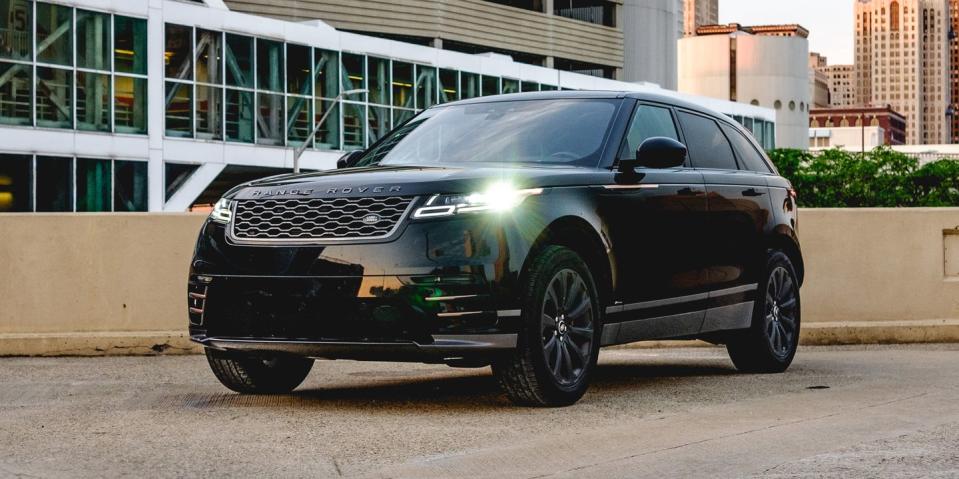
40,000-Mile Wrap-Up
That the logbook for our long-term 2018 Range Rover Velar has been essentially devoid of comments and service records since our last update at 33,000 miles is an unusual development for a vehicle that regularly rankled our staff with frustrations and reliability issues. Our most significant takeaway from that lack of ink after spending 40,000 miles with Range Rover's stylish compact luxury ute is that our example simply had overstayed its welcome.
In fairness, our Range Rover's massive 16,000-mile scheduled service intervals were partly at fault for the tapering off of activity in its logbook. During its stay, the Velar required just two basic oil changes and inspections, totaling $461. The additional cost of certain ancillary charges related to those dealer visits, such as a hefty $187 to have three new wiper blades installed, furthered our appreciation for the Range Rover's modest level of (expected) upkeep. A $50 expenditure to patch several stone chips in the Velar's windshield is the only new line item we have to report.
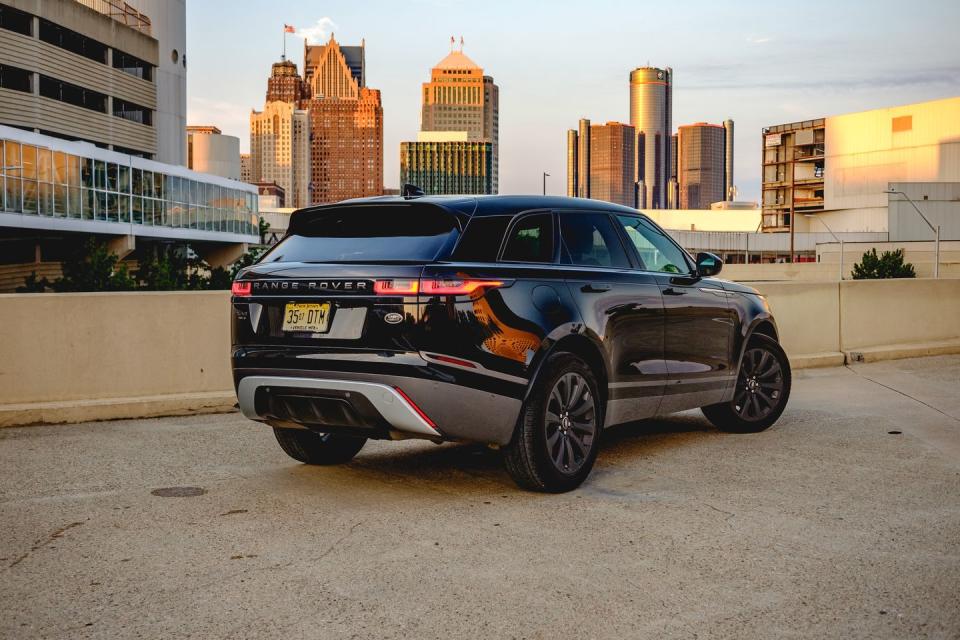
Alas, our long-termer visited the dealership more than we'd like, including stopping for a recall-related warranty replacement of a leaking fuel rail on its turbo 2.0-liter inline-four and to fix (also under warranty) a broken wire in the control unit of its telematics system, which immobilized the vehicle in a staffer's driveway, necessitating a tow. Yet those are only the issues that we officially reported to the service department. We can just imagine how many days out of use the Velar would've logged had we asked the service techs to chase down every intermittent warning light, electronic glitch, and powertrain hiccup that seemingly came and went at random throughout most of its time with us. A software update installed around 27,000 miles largely cured the Velar's dual-screen InControl Touch Pro Duo infotainment tablets of their propensity to freeze up and reboot while driving, but by then, the damage to our confidence and patience had already been done.
Not that the Velar had trouble eliciting opinions when it was working properly. Few drivers could deny its swanky presentation when pulling up to the curb or the upscale trappings of its high-tech cabin. Its toasty seat and steering-wheel heaters, as well as a heated and solar attenuating windshield, put it in high demand when winter storms rolled through town. And its decent size and easygoing demeanor made it a relatively capacious and capable member of the compact luxury SUV class.
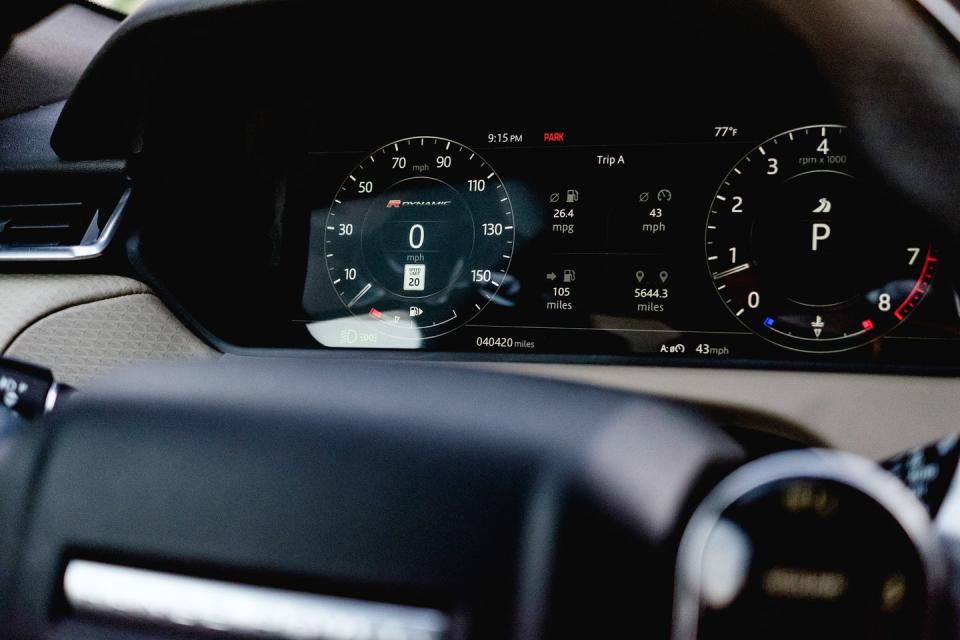
Conversely, it simply is unacceptable for an as-tested $67,235 luxury vehicle to not come standard with basic lumbar adjustment for its front seats (we would have had to pay an additional $3050 for the privilege on our mid-range P250 R-Dynamic SE model). The activation of the Ingenium four-cylinder's stop-start system shook the vehicle like an old-timey diesel engine. In practice, the Velar's touchscreen control surfaces make for a slow and clumsy arrangement even when operating as they should. And the relatively sluggish responses of the turbo four engine, coupled with Range Rover's relaxed calibration of the eight-speed automatic transmission, made our Velar less than graceful when asked to do anything quickly.
While it was not the most prolific road tripper in our long-term fleet, the Velar still managed to regularly stretch its legs throughout Michigan, as well as on voyages to Pittsburgh, Virginia, and Kentucky. Which made its 22-mpg average fuel economy—1 mpg less than its EPA combined estimate—all the more of a letdown. Dynamically, at 40,000 miles, the Velar's stopping distance from 70 mph improved by five feet, to 169 feet, versus when new, and its modest grip around the skidpad dropped a negligible 0.02 g to 0.82 g. More significant is that, despite its zero-to-60-mph time only slowing by a tenth, to 7.3 seconds during final testing, at 40,000 miles, the Velar needed nearly a second longer to accelerate from 50 to 70 mph (6.0 seconds) and almost two seconds longer to reach 100 mph (22.0 seconds).
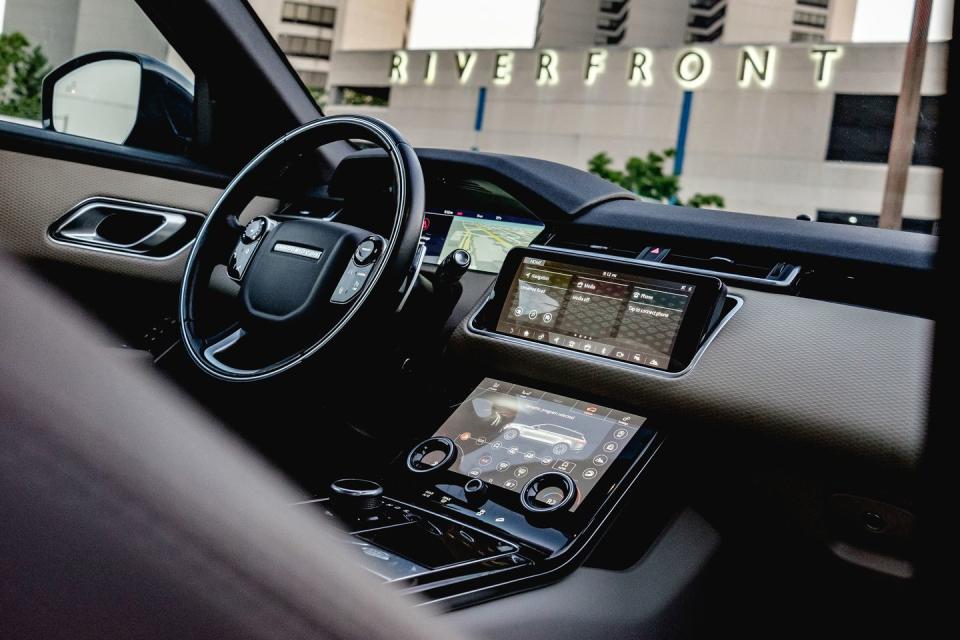
Looks can only go so far, and had we to conduct this test all over again, we may opt for one of the Velar's more powerful and expensive models powered by a supercharged V-6 or V-8. Yet, the mix of better-performing and better-functioning luxury alternatives at those versions' even higher price points is as thick as concrete. While our perseverance for informative reporting kept the Range Rover Velar in our garage for far longer than we imagine many buyers would tolerate, a pretty face or not, we don't miss it now that it's gone.
Months in Fleet: 18 months Current Mileage: 40,108 miles
Average Fuel Economy: 22 mpg
Fuel Tank Size: 16.6 gal Observed Fuel Range: 360 miles
Service: $601 Normal Wear: $187 Repair: $0
Damage and Destruction: $50
30,000-Mile Update

It's often the minor day-to-day quirks and occurrences, rather than life's big events and achievements, that guide a relationship's well-being. And so it is with our long-term 2018 Range Rover Velar, which, despite its stylish design and luxurious trappings, continues to grate on us as its odometer clicks past 33,000 miles.
Although our tony $67,235 Range Rover exudes curbside presence, many drivers struggle to find a comfortable seating position because of the electrically adjustable steering column's modest range of tilt and our particular example's lack of lumbar seat adjustment. Our complaints about Jaguar Land Rover's dual-screen InControl Touch Pro Duo infotainment system have been tempered—a software update by the dealer at 27,000 miles seems to have fixed many glitches and its tendency to reboot itself middrive—but the system remains sluggish, especially upon initial startup, and less intuitive to navigate than we'd like. As with many touchscreen-heavy interfaces these days, the Velar's glossy center stack is often coated in a haze of fingerprints.

The cost of basic care since our last update has added to our regular Range Rover bothers, including the $187 the dealer charged to replace three wiper blades and the $139 we shelled out to have service techs clean leaves out of the (still-new) cabin air filter, which had made it sound as if a playing card were stuck in the blower motor of the truck's climate-control system. That's on top of the $283 we paid for the Velar's scheduled 32,000-mile service visit that included an oil change, inspection, and the aforementioned cabin air-filter replacement.
A particularly worrisome unscheduled warranty repair was required at nearly 31,000 miles to fix a broken wire in the Velar's telematics control unit, which immobilized the vehicle in the driveway at a staffer's home. This necessitated a tow to the dealership, which sounds simpler than it turned out to be.
When the tow truck arrived, we learned that the Velar's electronics had failed to sufficiently prevent its electronic rotary shifter from operating, effectively leaving the transmission stuck in park and the pop-up dial planted in its lowered position. The owner's manual instructed us to cycle the system through a series of commands to restore the dial's functionality. When that didn't work, we searched for a manual release in or near the console, perhaps under the cupholder insert as in some other JLR products. But no.
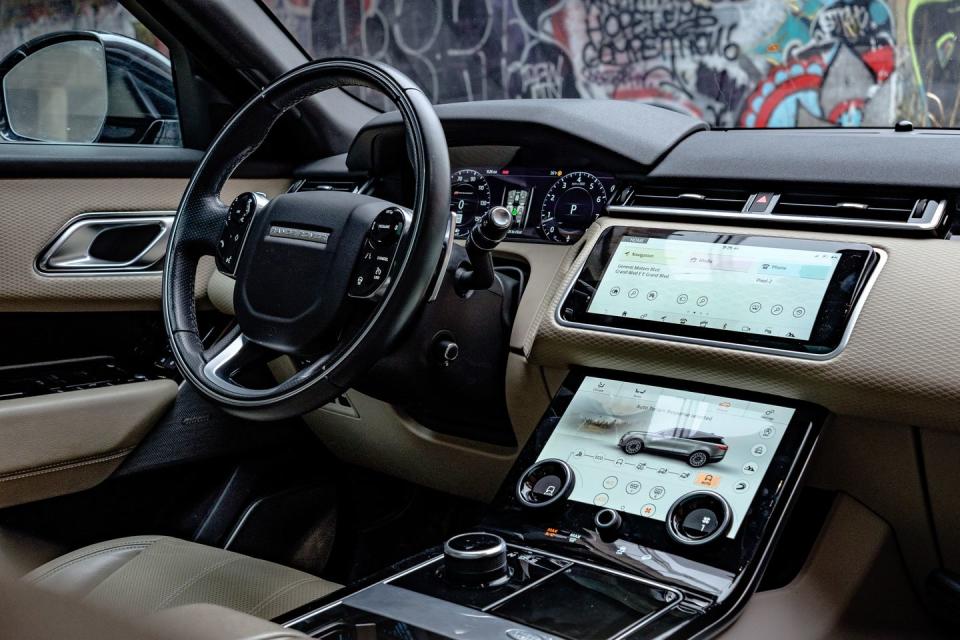
Resorting to an internet search, we learned that the emergency shifter release is a cable-and-lever arrangement hidden beneath the plastic engine cover, and we finally got the Velar onto the flatbed. Digging deeper into the printed manual after the fact revealed the following: "The recovery agent must activate the transmission park release before recovery commences. The procedure is covered in a separate publication for service personnel. Failure to activate the transmission park release can result in serious transmission damage." Our "recovery agent" was a AAA tow-truck driver sent by the dealer and was not privy to this separate publication. Pity any owner lacking the technical acumen to solve the towing problem, let alone our advantage of a fleet full of vehicles and a pair of road warriors standing by to make the 96-mile round trip to drop a substitute in the driveway.
While a check-engine light triggered by a known fault from the 2.0-liter inline-four's fuel-rail pressure sensor didn't strand us, it did require a separate dealer visit to correct, which included reflashing the control units for the engine and the transmission.

Despite the onset of spring in the Midwest and the refitting of the Rover's stock Pirelli Scorpion Verde All Season tires, our ute has stayed relatively close to its Metro Detroit base, which has kept its average fuel economy at 22 mpg—1 mpg less than its combined EPA estimate. Overshadowed only by our 2018 Alfa Romeo Giulia Quadrifoglio as the most troublesome vehicle in our current long-term fleet, the Velar, with its irksome ergonomics and cantankerous operation, continues to earn little favor as it closes in on 40,000 miles. Had we tied the knot with our own money, we definitely would have sought out relationship counseling by now.
Months in Fleet: 14 months Current Mileage: 33,464 miles
Average Fuel Economy: 22 mpg
Fuel Tank Size: 16.6 gal Observed Fuel Range: 360 miles
Service: $601 Normal Wear: $187 Repair: $0
20,000-Mile Update
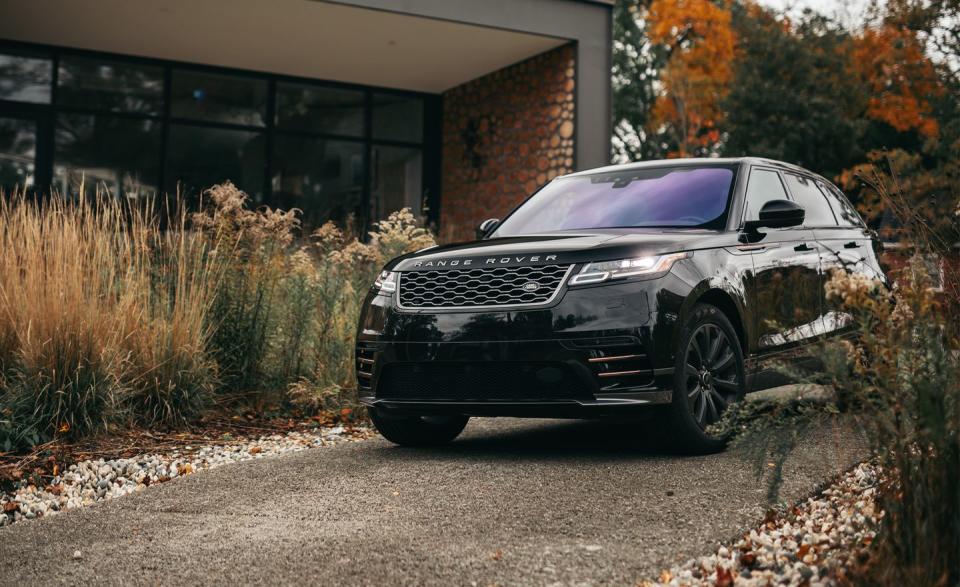
WHAT WE LIKE: Now past the halfway point of its 40,000-mile stay, our 2018 Range Rover Velar continues to exude a swanky presence wherever it goes, and it offers enough cargo space behind the rear seats (a class-leading 34 cubic feet) to ensure its occupants have everything they need once they arrive. The Velar also is a well-mannered road tripper, with both good stability at highway speeds and decent composure when the roads become more challenging. While our excursions off the beaten path have been minimal, consisting of windy, two-track trials that most all-wheel-drive crossovers likely could navigate, it's comforting to know that our Rover's optional Terrain Response 2 system will let it crawl over rougher ground with relative ease. That we've refitted a set of Pirelli Scorpion Winter tires in place of the stock all-season rubber means that we can expect our Velar to conquer the white stuff when it begins to pile up.

WHAT WE DON’T LIKE: Less enjoyable have been the Range Rover's ongoing electronic glitches that manifest as frustratingly temporary hiccups. Since our last update, noted short-lived episodes have included the climate-control system blasting hot air on a summer's day despite being set at 68 degrees, hyperactive parking and collision-warning sensors that occasionally sound alerts when creeping forward in a line of traffic, and a recalcitrant electronic rotary shift knob that sometimes refuses to move from its D setting. The InControl Touch Pro Duo infotainment system's dual touchscreens also remain a point of contention with their less than optimal ergonomic layout, slow responses, and tendency to momentarily go dark and reboot while we're driving. On occasion, the screens have even frozen up and ignored both touch inputs and those from the steering-wheel controls until the Velar is shut off and allowed to sit for a few minutes before restarting. "The Velar makes me swear in front of my children, which I rarely do," one driver wrote in the logbook. We also echo our previous complaints regarding the lack of lumbar adjustability in our Velar's front seats, the clunky engine stop/start system, and that the Velar often automatically shuts itself off when engaging park.
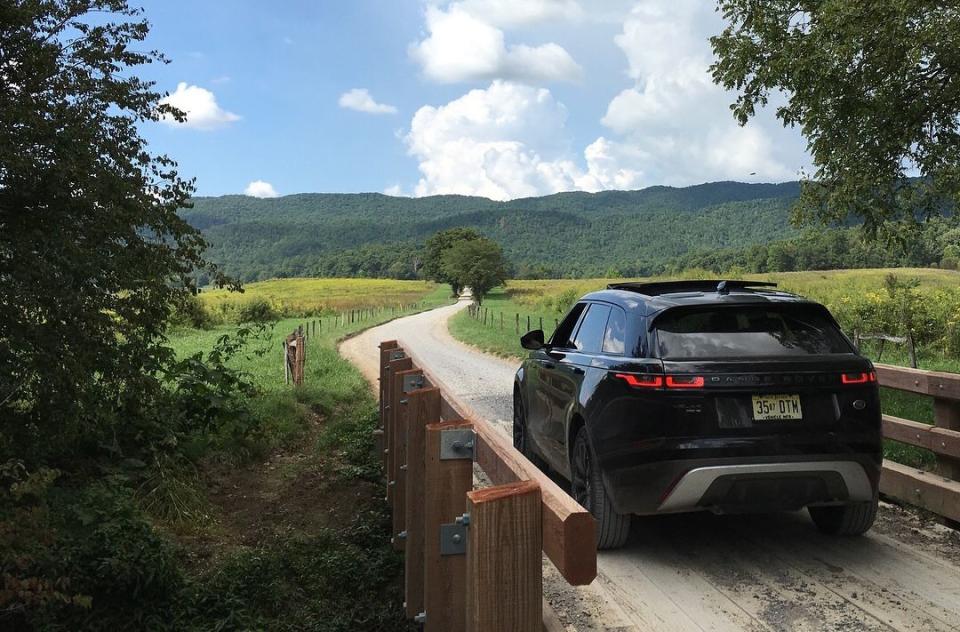
WHAT WENT WRONG: Other than the sporadic and varied electronic gremlins that never stick around long enough to warrant a trip to the dealer, the Velar has been trouble-free since our last update. The Rover's long, 16,000-mile service intervals mean our scheduled visits are few and far between.
WHERE WE WENT: While the four-cylinder Velar has mostly lived a commuter's life in southeastern Michigan—which hasn't helped to boost its 22-mpg average fuel economy, 1 mpg less than its combined EPA estimate—it has ventured to the western side of the state, made a quick jaunt to Indiana, and completed one near-1500-mile road trip to Tennessee and back.
Months in Fleet: 9 months Current Mileage: 22,096 miles
Average Fuel Economy: 22 mpg
Fuel Tank Size: 16.6 gal Observed Fuel Range: 360 miles
Service: $178 Normal Wear: $0 Repair: $0
10,000-Mile Update

WHAT WE LIKE: With its chiseled visage, chopped-top proportions, and concept-car interior presentation, our long-term Land Rover Range Rover Velar has an undeniably dashing aesthetic presence—one that some drivers have opined justifies the $67,000 price of entry by itself. Confident if uninspired handling and a healthy amount of cargo space behind the rear seats (34 cubic feet) has made it a popular choice for road-trippers, and the crisp infotainment graphics and luxury trappings of our R-Dynamic SE model have helped maintain a sophisticated vibe. It may be one of the junior models in Range Rover's hierarchy, but the Velar is never short on class.
WHAT WE DON'T LIKE: When that classiness is interrupted by the smell of gasoline from under the hood (more on that in a minute), intermittent and annoying glitches from the dual-touchscreen infotainment system, and front seats in which many drivers continue to struggle to get comfortable. While we haven't experienced any major electronic seizures since our last update, our affection for Jaguar Land Rover's InControl Touch Pro Duo interface remains hit or miss given its lethargic boot-up process, complex layout, and occasionally unresponsive controls. That all of the electronics-based issues have been short-lived—disappearing after cycling the engine or letting the vehicle sit overnight—has been both a relief and a frustration. And although some drivers have come away from long hours in the saddle with minimal gripes, our general regret for not upgrading our Velar's fixed-lumbar 10-way power-adjustable front seats to the available 20-way units with lumbar control—a $3050 upcharge—is firmly entrenched.
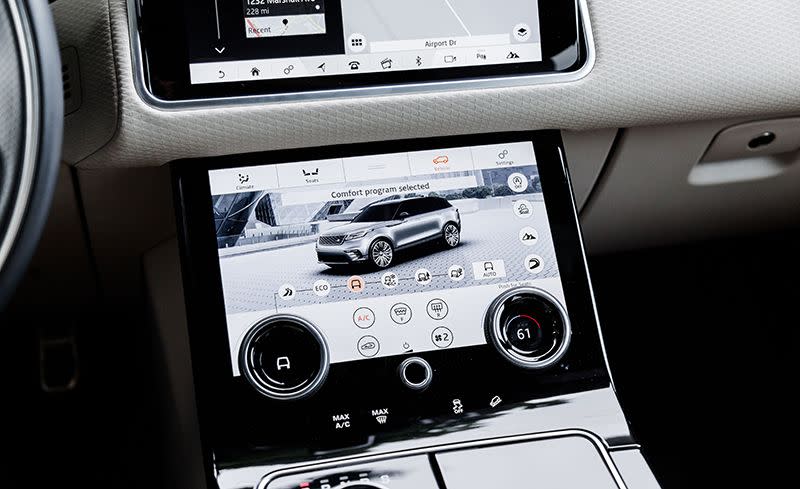
Other, lesser niggles that have worked into the Velar's logbook include a rather unrefined engine stop/start system that defaults to the "on" position with every startup and the tendency for the eight-speed automatic transmission to lug the turbocharged 2.0-liter inline-four at low revs in a high gear, which produces a grumbling resonance inside the cabin. While power from the Ingenium four-cylinder is fully adequate on the move, the gearbox's recalcitrance to downshift combined with the slight pause it takes for the engine to build boost pressure can make the Velar's throttle response feel sluggish.
WHAT WENT WRONG: Aside from the occasional electronic gremlins, our long-termer's only major problem thus far stemmed from the 2.0-liter engine's fuel-injection rail, the end caps of which began leaking fuel into the engine bay around 12,000 miles. This is a known issue with some four-cylinder Velars that prompted JLR to issue a recall notice in February 2018, and a quick trip to the dealer resulted in the fuel rail and all four fuel injectors being replaced under warranty. To date, our only expense has been $178 for a scheduled oil and filter change and inspection at just shy of 16,000 miles.

WHERE WE WENT: Despite its capaciousness and versatility, our Rover has largely lived a suburban-chic life so far, mostly staying close to home as a commuter around southeastern Michigan. The fuel-system recall canceled a potential trek into Canada for the Velar, although it did accompany us to Virginia International Raceway for our annual Lightning Lap event as well as make brief jaunts to Pittsburgh and Chicago since our last update. Stretching its legs on those trips helped boost our overall average fuel economy to 22 mpg, just 1 mpg less than the EPA's combined estimate.
Months in Fleet: 7 months Current Mileage: 15,926 miles
Average Fuel Economy: 22 mpg
Fuel Tank Size: 16.6 gal Observed Fuel Range: 360 miles
Service: $178 Normal Wear: $0 Repair: $0
Introduction
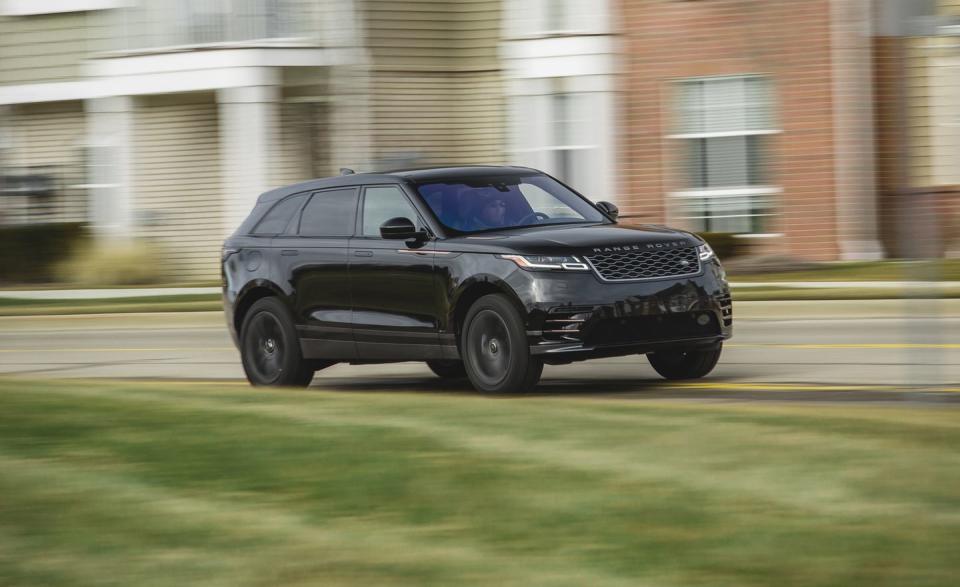
Despite the intrinsic constraints that an SUV’s utilitarian packaging can place on its designers, few can argue with the truly fetching two-box form that Jaguar Land Rover’s sculptors have made for the new-for-2018 Range Rover Velar crossover. But the Velar is more than just a pretty face positioned in the middle of Range Rover’s lineup of luxury utes: It also is outfitted with JLR’s new dual-screen capacitive-touch infotainment interface, which bolsters its case as a compelling subject for the 40,000-mile obstacle course that is our long-term test regimen.
While the Velar plays in a segment that includes the Audi Q5 and the BMW X3, its 189.1-inch length puts it curiously close to the larger Range Rover Sport, not to mention within spitting distance of the Jaguar F-Pace and the Land Rover Discovery within the JLR empire. Generous cargo space is a result of its sizable footprint, as the Velar tops its class with 34 cubic feet of storage behind the second row and 70 cubes with the 40/20/40 split-folding rear seats stowed almost flat.
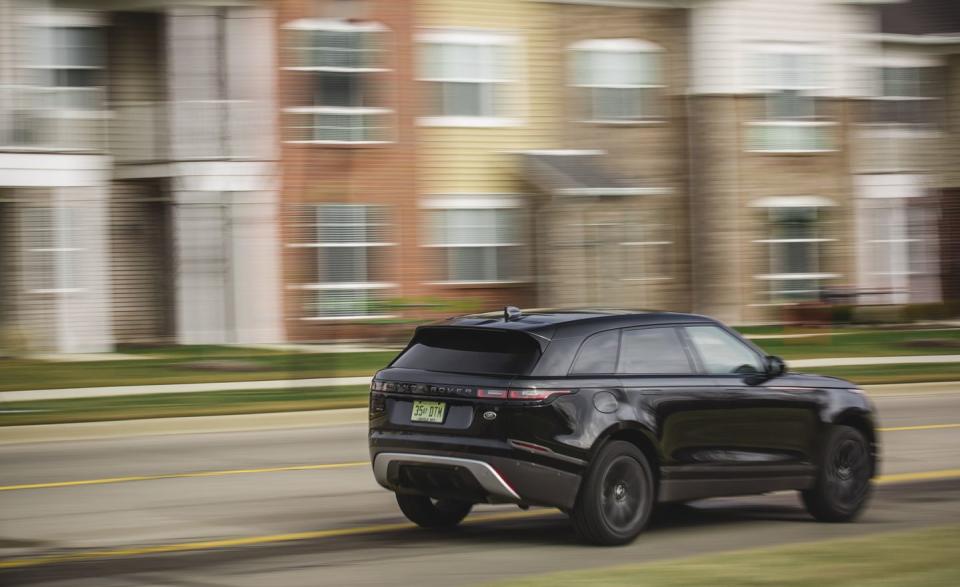
Dressed to Impress
We’ve had ample experience with JLR’s supercharged 3.0-liter V-6, which, along with a turbocharged 2.0-liter diesel inline-four, serves as the Velar’s uplevel powertrain. So for this test we deferred to its base engine, a gasoline-burning turbo 2.0-liter inline-four. Output is a decent 247 horsepower at 5500 rpm and 269 lb-ft of torque at just 1200 revs. A ZF-sourced eight-speed automatic is included, as is a full-time all-wheel-drive system with Rover’s Terrain Response system of selectable driving modes (Eco, Dynamic, Comfort, Grass/Gravel/Snow, Mud/Ruts, and Sand). Compared with the V-6–powered Velar P380 model we previously tested, our 4392-pound long-term vehicle weighs 284 pounds less.
Pricing for the entry-level P250 trim level starts at $50,895, but MSRPs can top $90K with the V-6 and a handful of options, including numerous interior color schemes and trim finishes. Our P250 R-Dynamic SE test car, which sits one rung below the top-spec R-Dynamic HSE model, started at $61,095 and features a coil-spring suspension rather than the adaptive air springs that come with the V-6, brake-based torque vectoring, full-LED head- and taillights, and darkened 20-inch wheels (18- to 22-inchers are available) wrapped with Pirelli Scorpion Verde All Season tires, size 255/50R-20. Other standard SE equipment includes automated emergency braking, lane-departure warning, a driver-condition monitor, a 360-degree surround-view parking assistant, specific front and rear fascias, heated and power-folding exterior mirrors with puddle lamps, and copper-colored accents on the hood and front flanks.

The Velar’s concept-car presentation carries into the modernist cabin with a 12.3-inch digital gauge cluster (on SE models and above) and the twin 10.0-inch InControl Touch Pro Duo infotainment screens in the center stack. Materials, including the satin-aluminum trim pieces and the geometric-patterned dash and door inserts, are attractive and feel high in quality. And there are ample amenities, including a panoramic sunroof, keyless entry and start, dual-zone automatic climate control, navigation, and an 825-watt Meridian audio system with 17 speakers.
Helping to inflate our example’s final tally to $67,235 was a $610 coat of Santorini Black paint and the $1495 Drive Pro package (adaptive cruise control, blind-spot monitoring, lane-keeping assist, and traffic-sign recognition). We also tacked on $1330 for front-seat heating and ventilation and heated rear seats, $615 for SiriusXM satellite radio, and $580 for the On/Off-Road package’s adaptive Terrain Response 2 system, All Terrain Progress Control (low-speed off-road cruise control), and configurable chassis and powertrain settings. Other extras included a $510 power-adjustable steering column, a $385 heated windshield, a $255 heated steering wheel, $205 for Argento Pinstripe interior trim, and $155 for a pair of USB ports in the second row.
Hitting the Road
While our long-termer’s black exterior and rose-goldish trim elements lend it a somewhat sinister vibe versus warmer color combinations we’ve seen, the Velar’s chopped-top silhouette and striking interior décor have earned it plenty of admirers. The power-extending door handles are a bit gimmicky—and they advertise when the vehicle is left unlocked—but overall the Velar positively nails the Range Rover aesthetic.
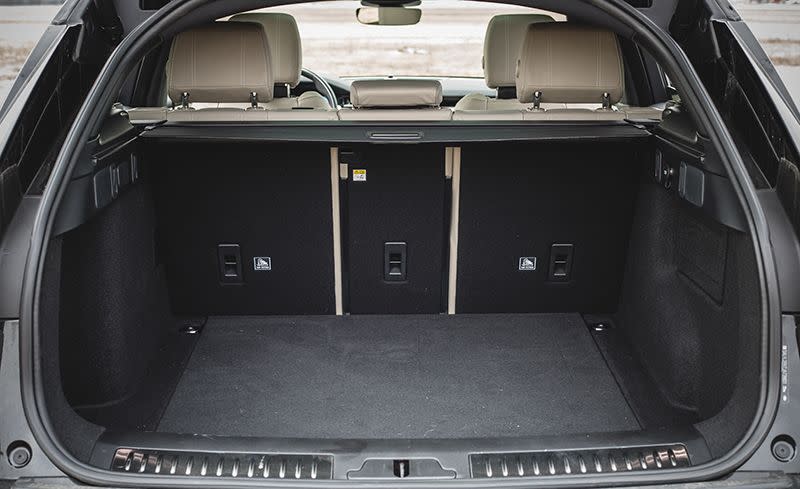
That it arrived at C/D HQ in February prompted us to fit a set of OE-size Pirelli Scorpion Winter tires ($250 each from Tire Rack) to get us through Michigan’s remaining cold months. A lengthy 2000-mile break-in period and extended winter weather delayed both our reinstallation of the all-season rubber and our visit to the test track. When we finally got there, the Velar did the zero-to-60-mph dash in a modest 7.2 seconds and covered the quarter-mile in 15.5 at 89 mph—adequately peppy but well off the 380-hp V-6’s times of 5.7 and 14.2 seconds. Its so-so 0.84 g of stick on the skidpad is par for the segment, as is its 174-foot stop from 70 mph.
We’ve otherwise taken it easy on the Velar, with initial logbook observations noting the ample power from the 2.0-liter engine but also some unimpressive clatter at idle. The P250 moves with little athleticism, and its tonnage means the four-cylinder rarely gets a break, but the eight-speed automatic shifts unobtrusively and pairs well with the engine’s surge of low-end torque. While the Velar never goads us into searching out back roads, its competent body control and generally comfortable suspension make it an easy cruiser elsewhere.
Less favorable have been the reactions to the P250’s fuel economy, which is EPA-estimated at 21 mpg city and 27 highway. We’ve averaged only 20 mpg thus far, which, with the Velar’s rather small 16.6-gallon fuel tank, means we’re usually filling up every 300 miles or so. Even at the 26 mpg that our long-termer returned on our 75-mph highway test loop, that’s only about 400 miles between fill-ups. Blame the Velar’s hefty curb weight for much of its thirst (the P250’s 23-mpg combined rating is 3 mpg better than the more powerful supercharged V-6’s).
A Familiar Future
Electronic gremlins have plagued several recent JLR test cars, including our last long-term Range Rover, a 2016 Td6 diesel model, so it was with mild trepidation that we welcomed this specimen into our fleet. It’s not surprising, then, that the most prominent comments in the Velar’s logbook have centered on its high-tech computer interface. For all its functionality and high-resolution graphics, the learning curve is relatively steep, and its extensive configurability has prompted even tech-savvy drivers to chide it for being overly complex. Others have acclimated more quickly, but having so few physical controls on hand means that interacting with the two tablets on the console is impossible to avoid.

The upper screen is largely responsible for audio, navigation, phone, and settings functions, with the lower primarily used for climate controls and the myriad driving-mode setups. But along with the configurability of the digital gauge cluster, many of the display functions, such as audio information, can be shown simultaneously on multiple screens; the two rotary control knobs integrated into the lower screen serve multiple purposes, depending on the function toggled on the display. Using them can adjust cabin temperature, fan speed, or seat heating and ventilation levels, as well as driving-mode settings (driver’s side only). We’ll likely grow more accustomed to the setup and fidget with it less as we configure it to our liking, but it still presents a lot of options to sort through while driving.
As we’ve experienced with previous JLR systems, touch inputs for the dual screens also occasionally respond slowly and inconsistently. And one morning, at just 2650 miles, both displays failed to awake when the vehicle was started. Although the audio system resumed where it had left off the day before—albeit without any way to adjust it—none of the other functions worked, and the computer refused to reboot itself even after multiple ignition cycles. The Velar apparently just needed a rest, as its systems were back to normal the following morning; since there was no way to re-create the issue and no warning code to analyze and clear, a trip to the dealer likely would have been unproductive. Another glitch occurred at about 3450 miles, when the center portion of the digital instrument cluster began scrolling wildly and was unable to properly render the navigation display. This time a tap of the Menu button on the steering wheel returned it to working order.
More frustrating was a temporary powertrain glitch at around 4400 miles, which seemed to prevent the 2.0-liter turbo engine from making any boost. “There was no check-engine light or any stumbling, but I could run the engine to redline with my foot on the floor while accelerating with all the might of an ’84 Ford Fiesta,” testing director K.C. Colwell wrote in the logbook. The incident persisted through multiple ignition cycles and also affected the transmission, which refused to kick down even when pressing the accelerator past the detent in its travel. As with the infotainment issue, the gremlins were gone the following morning and the problem has yet to resurface.
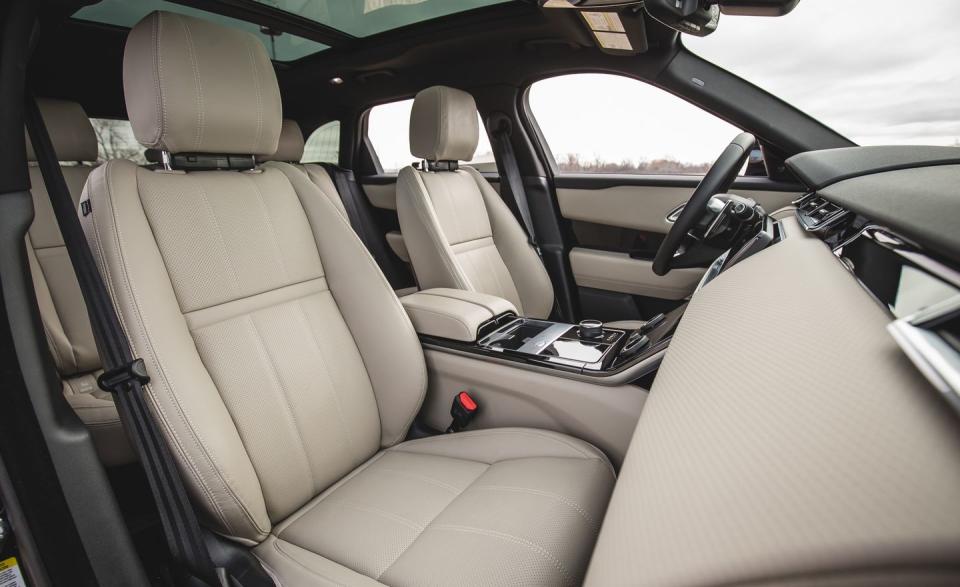
Taking a Seat
Other commenters have taken issue with the Velar’s 10-way-adjustable front seats, which have eight-way power adjustments for the bottom cushion and seatback and two-way manual adjustments for the bulky headrests. What’s lacking is any type of lumbar control—a frustrating omission both at the Velar’s price point and given the excessively padded lumbar section of the seatback, which many drivers have deemed uncomfortable. Although stepping up to the $68,595 P250 HSE model would bring fancier 20-way-adjustable chairs with massage and lumbar control, those would have cost an extra $3050 on this SE. We’ve also noticed that dash-mounted toll-road transponders such as E-ZPass have trouble operating through the Velar’s heated, solar-attenuating windshield, with one driver having to hold the unit out of the open sunroof so as not to cause a backup at the tollbooth.
The Velar’s 16,000-mile intervals for scheduled maintenance combined with a lack of any lasting issues means our long-termer has yet to visit the dealer. Our only expenditures have been for fuel and for purchasing and swapping out the winter tires. While the Velar has made one trek to Pittsburgh, the bulk of its early miles have been racked up on local commutes, along with a couple of short trips to western Michigan and Ohio. Although we have several issues to keep an eye on—and some drivers have already ruled out the Velar for long-haul travel due to its lumpy front seats—its stylishly tailored practicality should help it accumulate its remaining 32,700 miles in fairly short order.
Months in Fleet: 3 months Current Mileage: 7257 miles
Average Fuel Economy: 20 mpg
Fuel Tank Size: 16.6 gal Fuel Range: 330 miles
Service: $0 Normal Wear: $0 Repair: $0
You Might Also Like

 Yahoo Autos
Yahoo Autos 